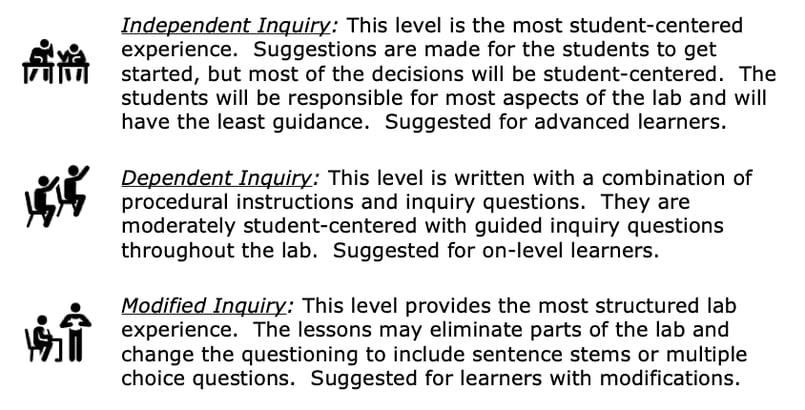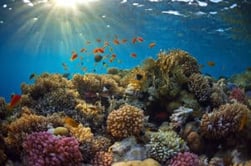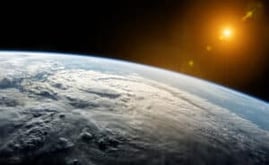Photosynthesis and Energy Inquiry Lab
Middle School Inquiry Lab on Photosynthesis and Energy
In this lab students will partially cover a de-starched plant leaf with paper before placing the plant in sunlight for three or more hours. Students will also test the leaf for products of photosynthesis.
Each inquiry lab will contain an essential question that will drive the lesson and make students think. For this lesson, the essential question is:
- How do plants transform the radiant energy of light into chemical energy?
BACKGROUND INFORMATION AND MATERIALS LIST:
Students will begin the lab by reading the essential question and background information. This can be done individually, as lab groups, or as a whole class. If you consider lab groups, you also might include some type of whole class formative checks before digging into the lab.

Materials List:
- warming station:
- heat source (hot plate)
- 500 mL beaker to deliver hot water to groups
- beaker with boiling water to kill leaves
- enough hot water (NOT boiling) for each group to have 200 mL
- oven mitt
- slotted spoon
- each group:
- Zip-lock sandwich bag with 12 orange, 18 yellow, and 6 red Skittles
- 1″ x 5″ wide strip of dark construction paper
- 2 paperclips
- 3 250 mL beakers
- stirring rod
- cold water
- 1 leaf still attached to a de-starched plant
- paper towel
- 5″ piece of string
- small plate/Petri dish
- eye dropper
- test tube
- rubbing alcohol/ethanol
- beaker
- goggles
- stopwatch/clock
- oven mitt
- iodine solution (0.1%)
PROCEDURE:
This is a lab that will span two class periods. On the first day, students will take their pick of a leaf on a plant that you have placed in constant darkness for 48 hours. Students will place a dark strip of construction paper on their leaf to keep that section of leaf covered until the next day. Until every group has made claim to a leaf, the plant will return to the darkness. When the last group has laid claim to their leaf of choice, you will return the plant into the sunlight for at least three hours.
While this is taking place, the students will be using their Zip-lock bag with candy to model the chemical formula of photosynthesis. Students will use their lab sheet to help visualize how the formula gets rearranged as the process of photosynthesis takes place.
On the second day, students will carefully remove their chosen leaf from the plant and begin to test if their plant created starches. Students will remove the strip of paper from the leaf, carefully attach a string to it and hand it to you so that you can boil the leaf for five minutes. This will ensure that the leaf will die, and all processes of photosynthesis will end. After this, students will carefully stuff the leaf into a test tube.
While the leaf is in the test tube, students will carefully add alcohol and place the test tube in a hot water bath. After five minutes in the hot water, the students will carefully remove the tube and begin to take out the leaf. Students will wash the leaf off with cold water and then place iodine over the surface of the leaf to see if it produced any starch while it was in the sun. Students will be looking for a color change due to the reaction with the iodine.
CHECK FOR UNDERSTANDING:
At this point in the lab, students will be checked for understanding by answering questions about their findings. Here are a few that come with the lab:
- How many molecules of water does it take to make one molecule of glucose?
- How many molecules of oxygen does photosynthesis release after making one molecule of glucose?
- Where does the carbon come from to create glucose?
- How does the pattern of the stain correspond to the placement of the dark paper?
- Where did the starch come from?
CONCLUSION
Students will go back to the essential question and write a CER (Claim, Evidence, Reasoning) to conclude the lab. Once completed, students will reflect back on their learning by answering the following questions:
- What are the products of photosynthesis?
- What does the lack of starch in some parts of the leaf tell us about what is necessary for photosynthesis?
- Explain the role of energy in photosynthesis.
MODIFIED AND INDEPENDENT INQUIRY VERSIONS
All of the Kesler Science inquiry labs come with three different modification levels. Each lab is differentiated using the icons below.
STANDARDS ALIGNMENT
TEKS: 7.5A – Students can recognize that radiant energy from the Sun is transformed into chemical energy through the process of photosynthesis.
NGSS: MS-LS1-6 – Construct a scientific explanation based on evidence for the role of photosynthesis in the cycling of matter and flow of energy into and out of organisms.

Download Over $100 in FREE Resources
For Middle School Science
Simply create a login below and gain immediate access to a selection of our Kesler Science product line worth $100 - for FREE. There's a full version of every product type! You'll also join tens of thousands of middle school science teachers who receive timely tips and strategies straight to their inbox.





